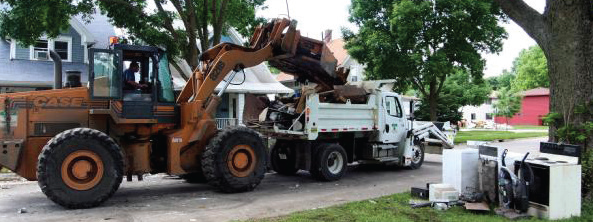Debris Management

In many cases, debris removal is the most expensive part of the response and recovery effort, so it is important to get it right! Debris removal is considered Emergency Work within the FEMA Public Assistance Program – that which is performed to reduce or eliminate an immediate threat to life, protect public health and safety, and to protect improved property that is threatened in a significant way as a result of an emergency or disaster event.
- direct result of the disaster.
- Within the designated disaster area; and
- On property and rights-of-way that are the legal responsibility of the Subrecipient (Applicant).
Typically, Subrecipients are local governments and eligible private nonprofits (PNPs). Eligible nonprofits are those that provide critical and essential governmental-type services.
Debris Management Plan
Debris Management Plans should address:
- Staff Roles + Responsibilities
- Situation + Assumptions
- Debris Collection
- Debris Management Sites
- Contracted Services
- Private Property Demolition + Debris Removal
- Public Information Strategies
Debris Management Plans
As a best practice, FEMA Public Assistance (PA) Subrecipients are highly encouraged to develop a Debris Management Plan. Plans significantly improve a Subrecipient’s ability to conduct debris management operations in a way that ensures debris-removal activities are tailored to meet specific needs and that are consistent with FEMA eligibility criteria.
A well-constructed Debris Management Plan ensures an Applicant maximizes the Federal funds it is eligible to receive and retains those funds through the reimbursement and audit process.
It is a subrecipient's responsibility to understand and follow all local, state, and federal regulations for debris removal, management, monitoring and operations.
The Debris Management Plan should include:
- Identifying a Louisiana Department of Environmental Quality (DEQ)-permitted debris management site.
- Pre-qualifying and maintaining a list of debris removal, monitoring and/or operations contractors.
- Developing a Request for Proposal (RFP) template for the solicitation of debris removal and monitoring contracts.
Contracting
FEMA provides a Debris Removal Applicant’s Contracting Checklist (Recovery Policy [RP] 9580.201) to assist Applicants in the procurement process in selecting a debris contractor. It is important to know that time and material costs are limited to work performed during the first 70 hours of actual work following a disaster. After 70 hours, contracts should be unit price or lump sum. Unit price is strongly advised.
Debris Management + Debris Monitoring
Best practices in contracting suggest maintaining an independent relationship between debris contract monitor(s) and the debris removal contractor. You should also consider assigning someone from your staff to be your Debris Manager. Part of his/her role is to provide oversight to debris contractors –both contracted monitors and debris removal contractors.
In-house Force Account Labor (FAL)
To minimize outside costs, it is important to consider using (in-house) force account labor (FALL) prior to awarding debris contract(s). Subrecipients are responsible for up to 25 percent of debris removal costs.
Documentation
The need for documentation cannot be stressed too strongly. Subrecipients must document all activities – for example labor, hours worked, kind of debris removed, quantity, location, etc. – whether by a contractor or FAL to ensure eligibility and reimbursements.
- Only FEMA-eligible and reasonable debris costs will be reimbursed.
- Only FEMA decides what is eligible and reasonable.



